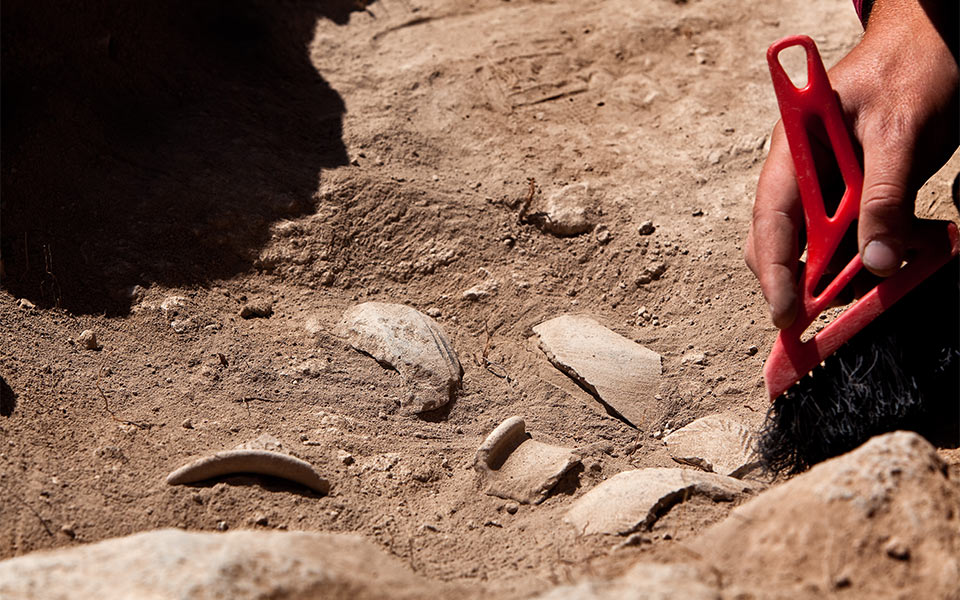With the arrival of the 2020s, it’s time to cast an appreciative eye back on Greek archaeology’s greatest discoveries during the 2010s. Greek and foreign archaeologists made extraordinary finds during this period, with their activities ranging from field surveys and excavations – both on land and underwater – to state-of-the-art cleaning, conservation and analysis in the laboratory.
The spectrum of discoveries is breathtaking: magnificent chamber tombs; lost cities and buried cityscapes; millennia-old sunken ships; intriguing inscriptions; miniature masterpieces of art carved in semi-precious stones or painted on cave walls; richly interred warriors; skeletons of still-shackled prisoners; and once-busy ports.
Not all the great discoveries were made inside Greece, as finds from outlying areas such as Egypt and Sicily have included Greek temples, cargo-laden ships, gold coins, colossal statues and extensive, tomb-filled cemeteries.
First Up: Honorable Mentions
Through the last decade many smaller archaeological studies have contributed profound and dramatic results.

© Dimitris Vlaikos
Dating a Cataclysm
The radiocarbon dating of a piece of charred olive wood from the islet of Thirasia has shown that Santorini’s massive Bronze Age eruption, previously dated to ca. 1613 BC, actually occurred some decades later, in the early 1500s BC.
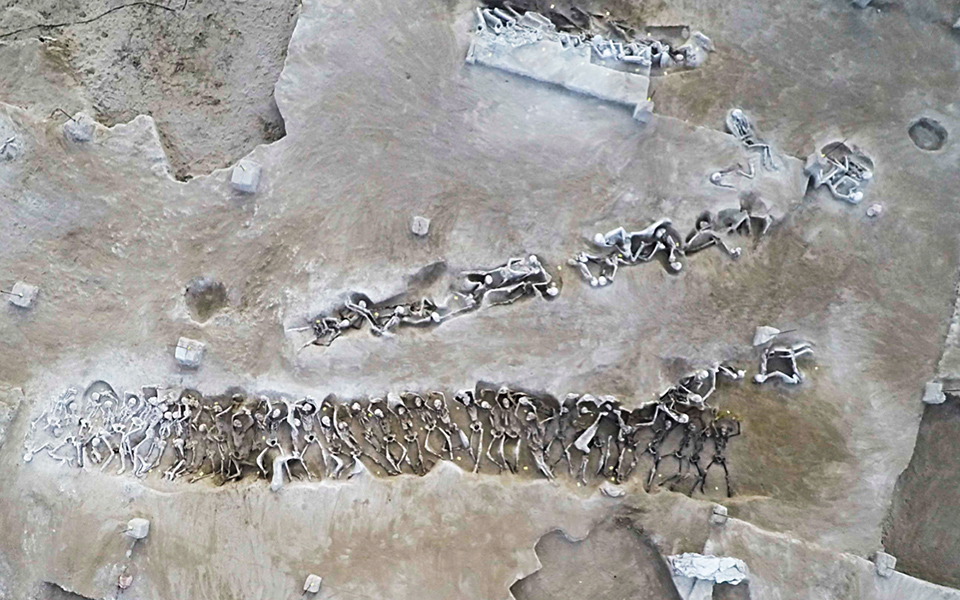
A Grisly Discovery
A mass grave of the 7th c. BC, containing at least 80 adult skeletons, their hands bound with iron shackles, was unearthed in an ancient necropolis in Faliro in 2016, during the construction of Athens’ new Stavros Niarchos Foundation Cultural Center. They may be the executed followers of the Athenian aristocrat Cylon, whose attempted takeover of the city’s government in 632 BC ended in failure.
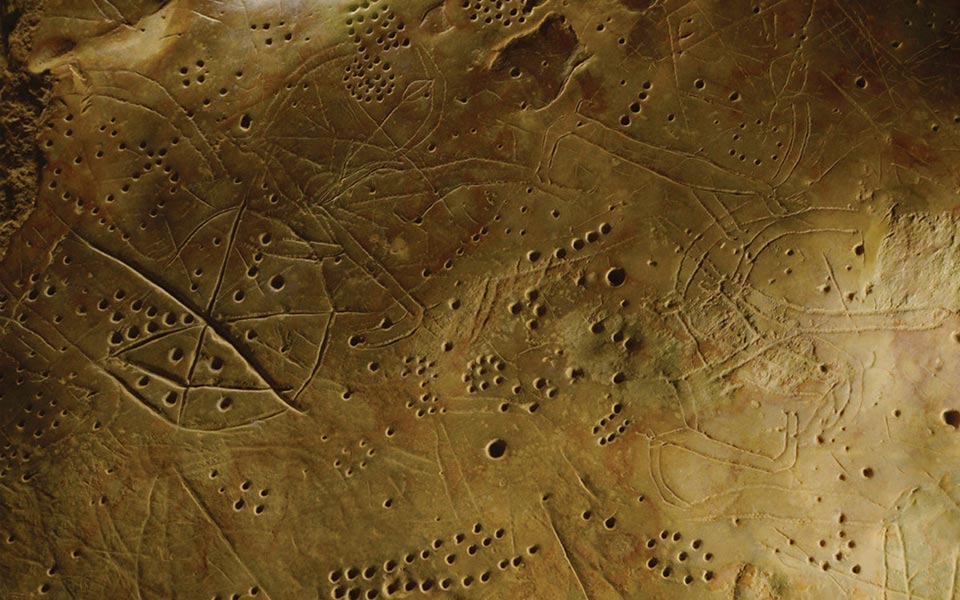
© S. Murray and C. Kolb CC BY-NC-ND 4.0
Greece’s Oldest Known Artworks
Petroglyphs showing a herd of distinctively antlered, now long-extinct dwarf deer, reexamined on the walls of Asfendou Cave (Sfakia, Crete) in 2018, have been determined – through improved, photogrammetric recording techniques, combined with the results of earlier studies of fossilized remains in Crete – to be 11,000 years old… thus making them Greece’s earliest-known figural art.
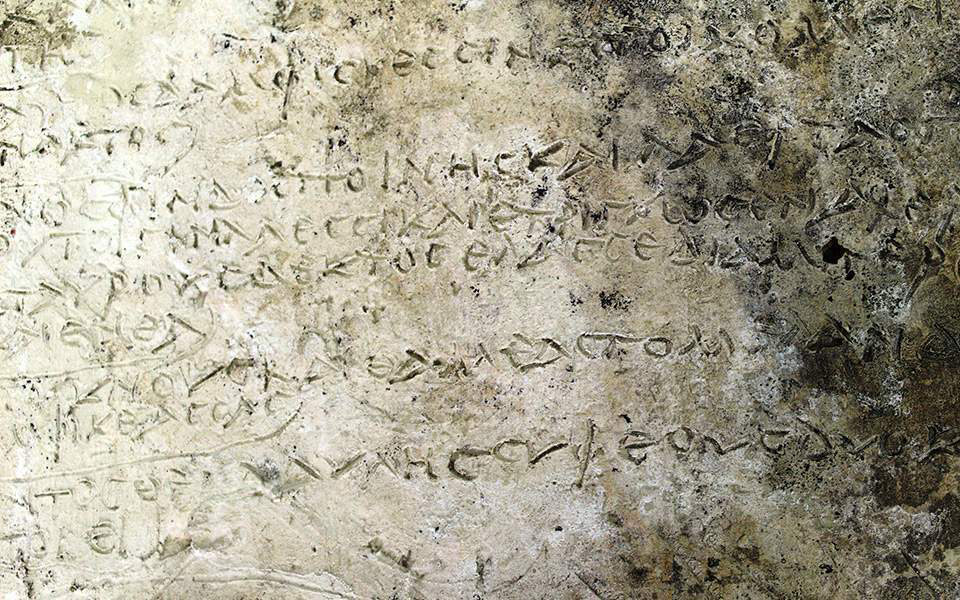
© Hellenic Ministry of Culture and Sports
Homage to Homer
The oldest-known written excerpt of Homer’s Odyssey was stumbled upon in 2018 during works at ancient Olympia, which consists of thirteen verses from Book 14, inscribed on a clay tablet from the 3rd c. AD.
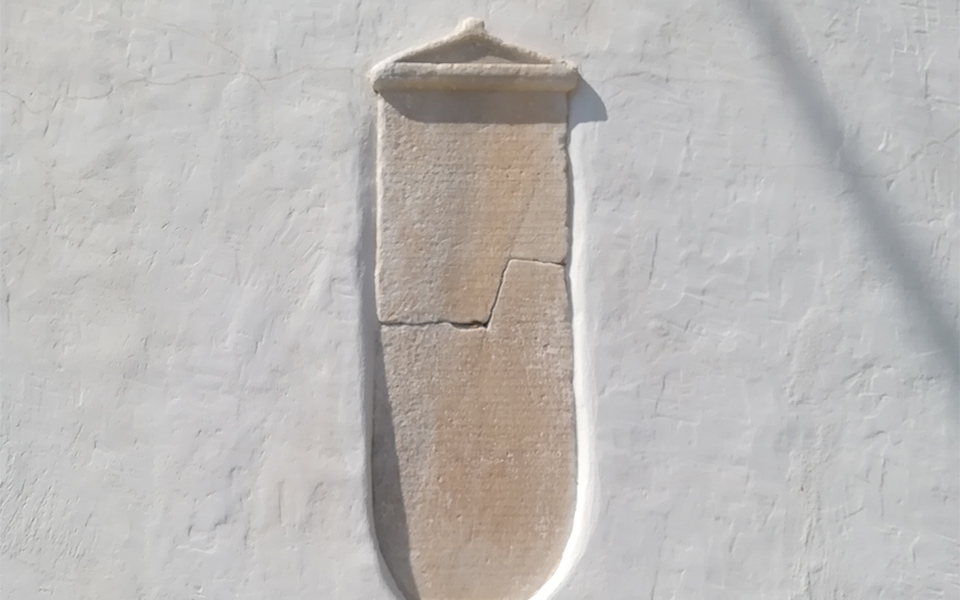
© Hellenic Ministry of Culture and Sports
Lost and Found
And just to show that delightful discoveries, large and small, still remain to be found all around us, an official decree inscribed on a stone stele in the 3rd c. BC, known as the Resolution of Nikouria, was rediscovered in 2018 – after originally being found in 1893 but mysteriously disappearing in 1908! Now it has at last been recovered on the island of Amorgos, where it had been built into the outside wall of house in Tholaria village, once belonging to a shepherd from the nearby islet of Nikouria.
AND THE TOP 5 ARCHAEOLOGICAL FINDS OF THE DECADE:
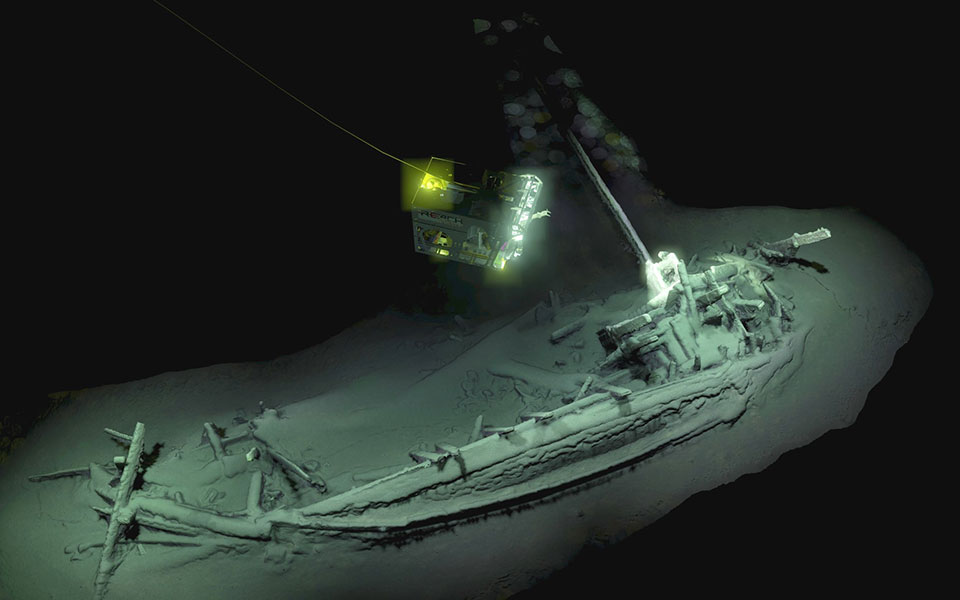
© Black Sea Maritime Archaeology Project (MAP)
#5 – Treasures from Poseidon
As technology rapidly advances, marine archaeologists have had increasing success in wresting historical secrets from the deep. In 2018, an Anglo-Bulgarian team, using deep-water cameras some 43 nautical miles off the west coast of the Black Sea, discovered a 23 m-long, early Hellenistic merchantman (ca. 400 BC), the “world’s most intact ancient shipwreck,” resting with its mast, twin rudders, rowing benches and even its cargo on a silty seabed more than 2 km below the surface.
Thanks to the findspot’s low-oxygen environment, the exact workings of the steering system, and other long-enigmatic details in the construction of ancient wooden ships, may at last be illuminated.
In other significant underwater work, a survey off the coast of the Fournoi islands, in the long-notorious strait between Ikaria and Samos, has revealed a graveyard of more than 50 shipwrecks since 2015, marking a crucial north-south sea lane frequented by commercial vessels from at least the 6th c. BC through post-Byzantine times. Major port studies have also been completed or launched.
A seabed survey off Delos island in 2017 discovered 7 wrecks (6 late Hellenistic, 1 Roman), as well as columns, walls and sturdy foundations belonging to a secondary harbor in Skardanas Bay.
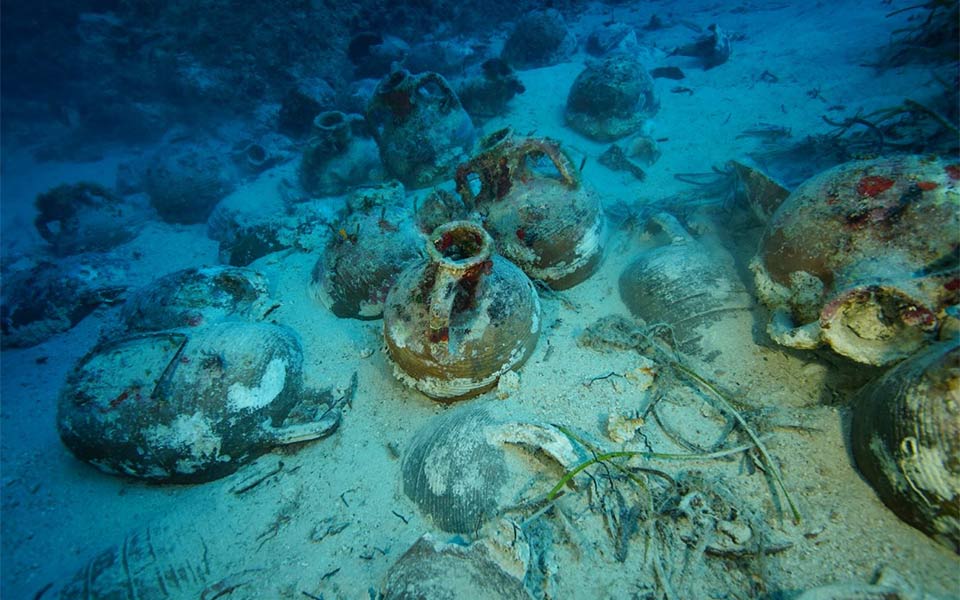
© Hellenic Ministry of Culture and Sports
On the Greek mainland, the Zea Harbor Project (2002-2012) completed its last two campaigns, ultimately concluding that Piraeus’ three ports once held nearly 400 ship sheds for war triremes, with vast roofs that would have covered about 100,000 sq. m. Project director Bjorn Loven has now opened a new study of Corinth’s Lechaion port (since 2013).
Elsewhere, Greek and Finnish archaeologists at Salamis began in 2016 to expose the island’s ancient port, where the Athenian navy assembled on the eve of the great Battle of Salamis in 480 BC. Excavating the western shores and seabed of nearby Ampelakia Bay, beside the Kynosoura peninsula, port-side structures and harbor installations have come to light, dating from late Classical/Hellenistic through Roman times (late 4th c. BC – 3rd c. AD), along with a fine marble head of a youth, whose carving recalls the workshops of Skopas or Lysippus.
Important coastal installations have also appeared at the top of the Aegean, where a 40+ m-long seaside stoa (colonnaded row of shops) was discovered at Argilos in 2013. Constructed after the mid-600s BC, the Argilos stoa is “the oldest example to date from northern Greece and is truly unique,” according to project co-director Jacques Perreault. Argilos was the first Greek colony in the area, located near the mouth of the Strymonas River, which quickly became an affluent port city involved in the export of the region’s gold and silver resources.
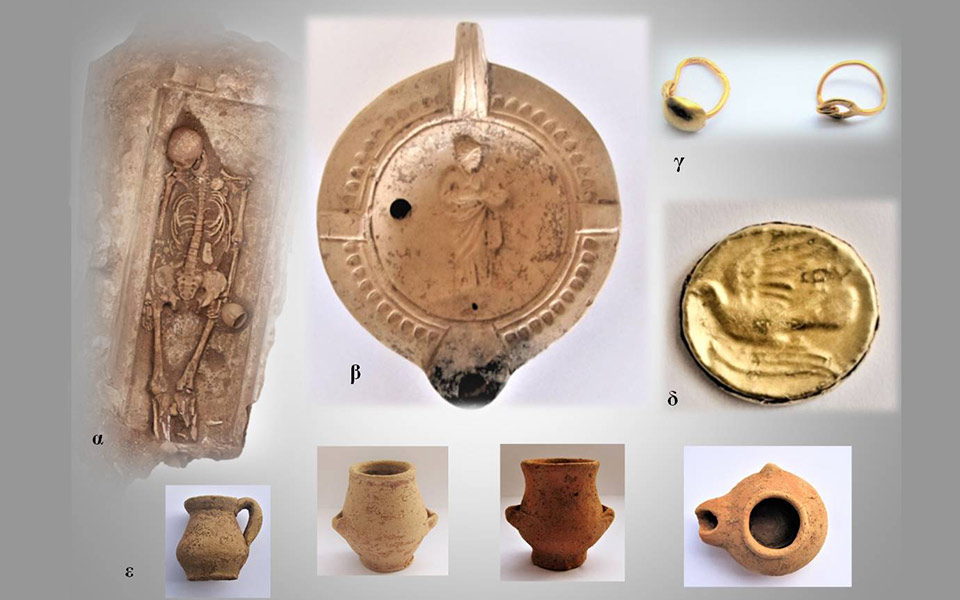
© Hellenic Ministry of Culture and Sports
#4 – Lost cities: Tenea (Greece); Heracleion (Egypt) (2019).
Just as Heinrich Schliemann, armed with Homer’s Iliad in one hand and his spade in the other, brought Troy out of the pages of ancient literature and into the light, so has archaeologist Elena Korka confirmed the location of ancient Tenea, about 20 km east of Nemea. Although the city’s location outside Chiliomodi village was long suspected, and systematic investigation began in 2013, it was not until 2018 that Korka’s team positively identified the site through their discovery of a residential area, including houses, water pipes, marble floors, a large bath complex, locally minted coins and numerous graves.
Funerary evidence points to inhabitation from Geometric through Late Roman times. Lying on a main route between Corinth and Argos, Tenea was an affluent, independent, commercial city that flourished especially under the Romans. Known for supplying most of Corinth’s colonists to Syracuse, and as the place where mythical Oedipus grew up, the actual city has at long last emerged from age-old legend and the literary mists.
Even more spectacular discoveries from a lost Greek city have come from Thonis-Heracleion, an underwater site in the midst of Abukir Bay, NE of Alexandria, Egypt. First spotted from the air by a British RAF pilot in 1933, the exact spot was finally pinpointed in 2000 by archaeologist Franck Goddio, who then described Heracleion as “an intact city, frozen in time.” In the last decade, discoveries have increased, with 2019 marking a particularly fruitful year. Among the most recent finds are two temples, part of a large ceremonial boat, gold jewelry and coins, many from the reign of Ptolemy II (283-246 BC). Once a main regional port, visited by historical and mythical figures including Cleopatra, Heracles and Paris and Helen, the city’s end came from earthquakes and subsidence, perhaps especially in AD 365, when, like legendary Atlantis, Heracleion sank into the sea.
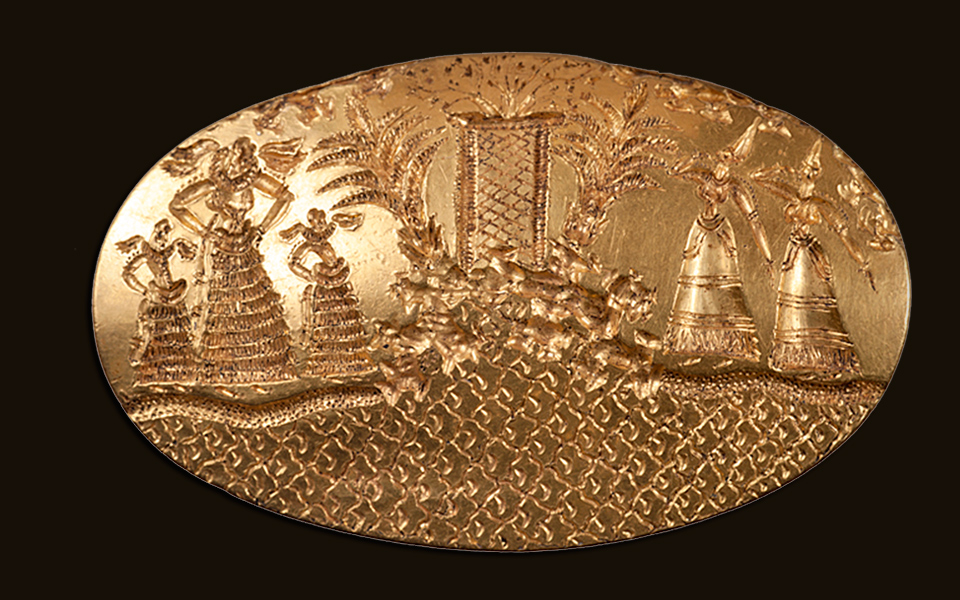
#3 – Royal Riches & State Formation at Pylos
Amazing finds just never seemed to stop coming from Pylos, in the southwestern Peloponnesos, during the past decade, with the so-called Griffin Warrior Tomb (2015) perhaps being the most impressive. Dated to about 1450 BC, the undisturbed Late Bronze Age (LBA) grave contained more than 3,500 burial goods, including gold-handled swords and daggers; four gold rings and a thick chain; gold, silver and bronze cups; six ivory combs and a plaque engraved with a griffin; a possible boar’s-tusk helmet; and numerous seal stones with minutely carved scenes.
Among the latter is the exquisite “Pylos Combat Agate” (revealed after its cleaning in 2017), which, like many other items in the tomb, was imported from Crete, according to archaeologists Jack Davis and Sharon Stocker. Although the grave lies near the Palace of Nestor, this unknown Mycenaean warrior died before its construction and may have been an early ruler of Pylos with ties to the influential Minoans.
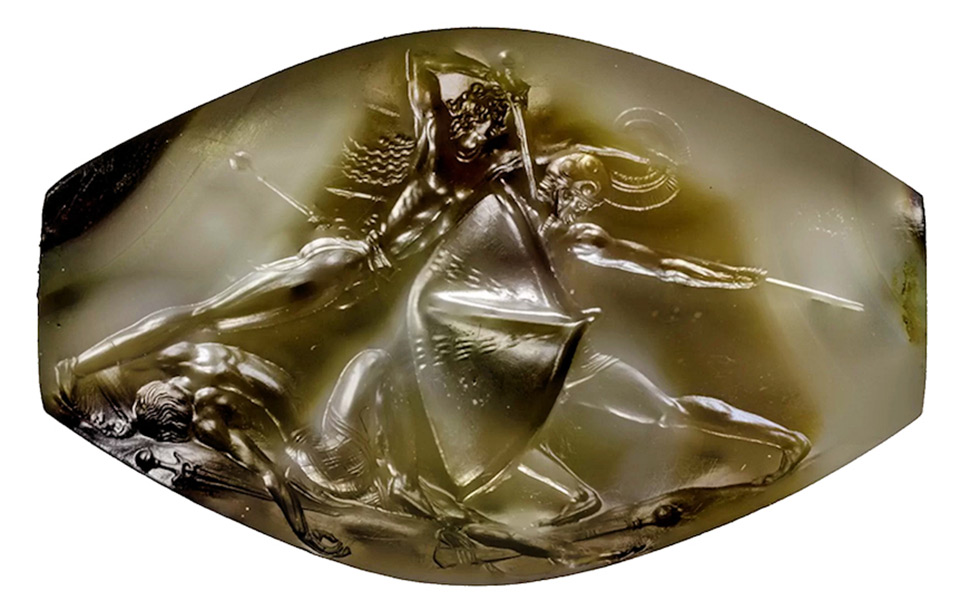
© The Department of Classics, University of Cincinnati
The Combat Agate depicts a battle between two warriors, a scene paralleled on a seal and a gold ring from Mycenae. Further evidence of affluence and Cretan connections turned up in 2018, when Minoan imports were discovered in two “tholos” or “beehive” tombs (ca. 1500 BC) near the palace, as well as thousands of flakes from luxurious gold leaf that once lined their walls.
In 2011, meanwhile, archaeologists at nearby Iklaina, some 8+ km southeast of the Palace of Nestor, unearthed the oldest-known Linear B tablet (1350-1300 BC). More recently, project director Michalis Kosmopoulos has reported the Mycenaean settlement to be a subsidiary regional capital, indicative of an early multi-tiered federal state. Discoveries included two major administrative buildings, fragments of ornate wall paintings, paved streets, public squares, pipes for supplying water and a sewer system – all previously associated with the large Mycenaean palace complexes.
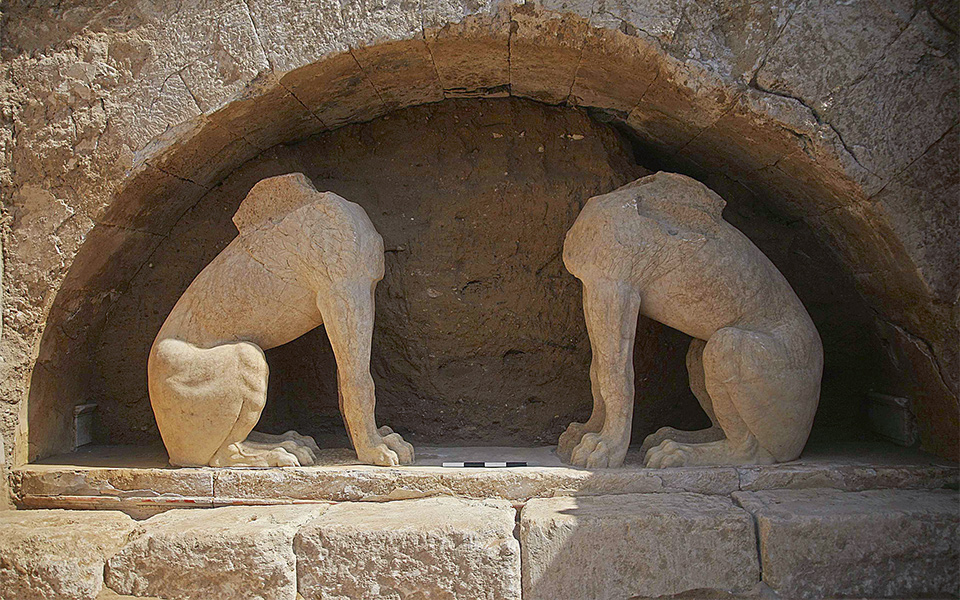
© Konstantinos Tsakalidis
#2 – Kasta Hill Tomb, Amphipolis
The discovery drawing the most media attention, enthusiasm and speculation, among scholars, the public and government officials, is the three-chambered resting place of an ancient VIP, uncovered in 2012 on Kasta Hill at Amphipolis. Ranking as the largest tomb ever found in Greece, it is surrounded by a circular, 500 m-long, 3 m-high wall of polished Thassian-marble…158 m in diameter!
Who this tomb belonged to remains a much-debated mystery; it has been attributed by various specialists to either the early Hellenistic or Roman period. Featuring a barrel-vaulted ceiling, two monumental entrances flanked by sphinxes and caryatids, marble doors and a polychrome mosaic floor depicting the mythical abduction of Persephone into the Underworld, led by Hermes, the tomb clearly belonged to someone important.
Although Alexander the Great and his friend Hephaestion have been floated as candidates, the presence inside of an elderly (60+) woman, two middle-aged (35-45) men, a newborn and a fifth cremated individual, probably an adult, suggests this was the tomb of an affluent, leading family, which may even have been reopened several times in antiquity to accommodate its newly deceased members.
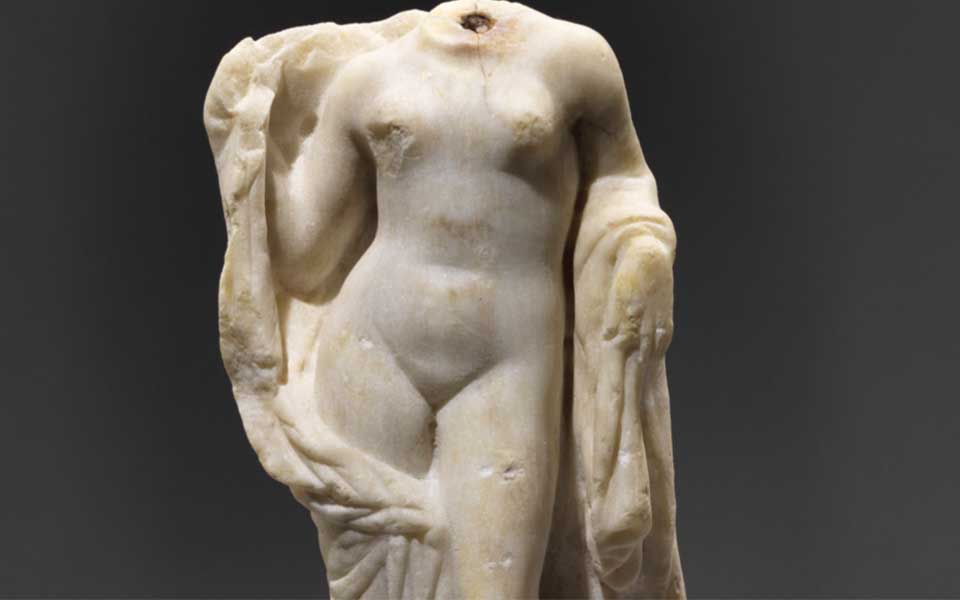
#1 – Thessaloniki Metro Antiquities
Without question, the greatest discovery in Greece, unearthed during the largest archaeological excavation ever conducted in northern Greek history, is the ancient cityscape (4th – 9th c. AD) revealed beneath modern Thessaloniki. Following the launch of the city’s Metro project in 2006, the ongoing dig has intensified over the past decade, employing up to 300 personnel of all specialties.
Now, having brought to light more than 300,000 artifacts, as well as stone-paved avenues, city squares, shops, workshops, stoas, houses, two Early Christian churches, water/sewer systems and thousands of graves, archaeologists are again being challenged to preserve as much as possible of Thessaloniki’s precious heritage.
With archaeology-related costs estimated to reach more than 75 million euros, Greece’s new government has recently reversed itself and green-lighted the removal of antiquities to make way for Metro stations.

